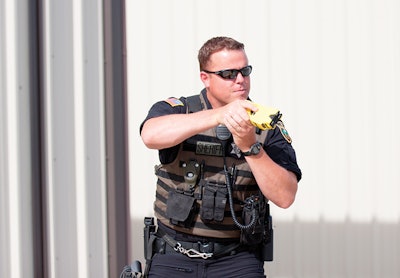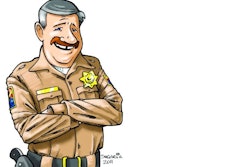 Photo: Carla Blazek
Photo: Carla Blazek
The vast majority of arrests are accomplished without any force being applied by police officers. Most people do what officers ask of them and this results in officers simply placing handcuffs on arrestees, searching them, and transporting them to a correctional facility or police station. Still, a small percentage of arrestees resist arrest, an even smaller amount actually use force against arresting officers, and the chances of officers having to use deadly force during their careers is less than 1%.
The amount of resistance or force exhibited against an officer can vary greatly, and accordingly the officer's response must be objectively reasonable. However, in addition to the behavior of the arrestee, other factors dictate the officer's force. These factors are based on the basic tenets determined by the Supreme Court in Graham v. Connor, 490 U.S. 386, 1989. As with all use-of-force encounters, the force the officer uses must be based on the "objectively reasonable officer" criteria, considering the officer's perception at that moment and the "totality of the circumstances."
Determining whether the amount of force used by an officer is appropriate also "requires a careful balancing of the nature and quality of the intrusion on the individual's Fourth Amendment interests against the countervailing governmental interests at stake." Graham v. Connor also tells us that police officers often have to make split-second decisions and that it is unfair to use hindsight to evaluate an officer's response.
Analysis of Circumstances
Proper and excessive use of force and how to distinguish between the two can be understood by discussing different scenarios with varying circumstances. To determine if the force used was objectively reasonable, it is helpful to examine all the circumstances, including: the severity of the crime, degree of physical threat, offender size and ability, officer size and ability, availability of weapons, other persons present, number of officers present, and the subject's actions. If deadly force was used, we must determine if there was an imminent threat of death or great bodily harm to the officer or someone else.
Let's look at a scenario.
Scenario—The arrestee committed a theft, used force against the officer, and then fled the scene on foot. The officer pursued on foot, ordered the subject to stop, and threatened to use a TASER on the subject. The subject kept running and the officer stunned the subject. The subject went to the ground and was immobilized. The subject was taken into custody with no further force.
The information provided in this scenario is insufficient to determine if the force was reasonable, as you will see as you read further.
Scenarios and Analysis
Let's look at the following scenarios to practice analyzing the use of force by examining the tactics relative to all the circumstances to determine if the force was objectively reasonable.
Scenario One—An officer is dispatched to a gas station for a young male who has just shoplifted a bag of potato chips and is now hiding behind the gas station eating them. When the officer arrives, the youth—who appears to be 13 or 14 years old; 5-foot, 2-inches tall; and 130 pounds—is standing by a small aluminum garbage can eating the chips. The youth kicks the garbage can toward the officer and the can strikes the officer's legs. The youth then runs away. The officer, who remained standing, begins to run after the youth and threatens to use his TASER. The youth keeps running and the officer stuns him, causing him to fall to the hard pavement from a sprint, causing the youth to strike his head. This results in a head injury requiring stitches and a possible concussion. The officer is 6-feet tall and 190 pounds.
Analyzing the Scenario—Stealing potato chips from a store is not a serious crime and the degree of threat presented by the teen kicking the trash can toward the officer was minimal. The offender was small, especially in comparison with the officer. There were no known weapons available to the suspect. No other officers or persons were present. The subject kicked a can at the officer, but it did not cause any serious injury, as the officer was able to pursue the subject. In this scenario, the force would be seen as excessive.
Scenario 2—The officer is dispatched to a jewelry store where the suspect has stolen $5,000 worth of jewelry and was last seen heading east on Green Street. The suspect is described as a white male; 6-foot, 5-inches tall; 225 pounds; and muscular. The officer arrives in the area and sees a man matching the description just three blocks from the jewelry store walking east on Green Street. When the officer pulls up to the subject and exits his squad car, the subject runs toward the officer and shoves him. The subject then starts running away and pulls from his jacket what appears to be a metal pipe. The officer pursues the subject, ordering the subject to stop, and threatening to TASER him. The subject continues to run. The officer stuns the subject and the subject is immobilized and drops to the ground, causing a laceration on his forehead and a possible concussion. The subject is then taken into custody without any further force needed. The officer is 6-feet tall and 190 pounds.
Analyzing the Scenario—The crime was a felony due to the value of the stolen items. The threat became serious because of the seriousness of the offense and the fact that the suspect shoved the officer and displayed a metal pipe. The suspect was large and muscular and outsized the officer. No other officers or persons were present. When analyzing all the circumstances, the officer's use of force was objectively reasonable.
Final Thoughts
The scenarios we have examined are extremes. However, the criteria for analyzing use of force can be easily illustrated using these scenarios. I encourage officers to use these criteria and this method to analyze use-of-force scenarios that have occurred in their departments or are in the media, or simply make them up for training purposes. Officers must continue to train to properly perform their jobs.
Determining whether a use-of-force situation is reasonably objective or an excessive use of force can be challenging. But it helps to look at as many of the details as possible. An experienced officer should be able to look at the severity of the crime, degree of the threat, offender size and ability, officer size and ability, availability of weapons, others present, and so on to draw a reasonable conclusion. This practice will provide important training to officers working the streets.
Dr. Michael Schlosser, Ph.D., is the director of the University of Illinois Police Training Institute, and the Institute's lead control and arrest tactics instructor. He retired from the Rantoul (IL) Police Department as a lieutenant.












